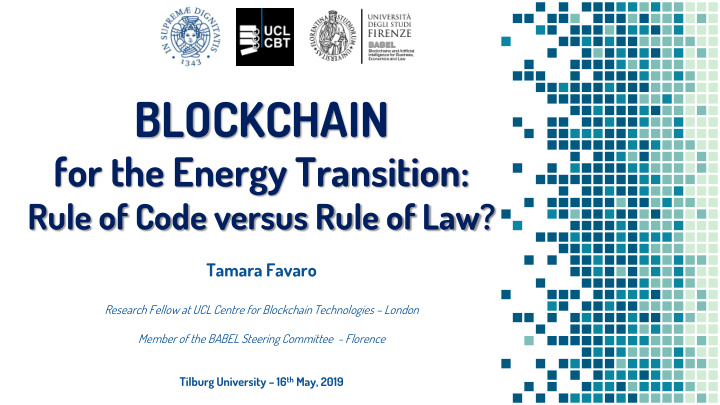



BLOCKCHAIN for the Energy Transition: Rule of Code versus Rule of Law? Tamara Favaro Research Fellow at UCL Centre for Blockchain Technologies – London Member of the BABEL Steering Committee - Florence Tilburg University – 16 th May, 2019
OUTLINE ▪ Context xt ▪ Resear earch h Quest stions ions ▪ Regul ulat ator ory failur ures es ▪ Possibl ssible e Blockc kcha hain in app pplic ications ations ▪ Conc nclusions usions 2
Context Three fundamental concepts - Blockchain kchain : : a public, immutable, transparent distributed ledger - Smart t contrac tract: : a line of code that automatically execute a specific function once certain conditions are met, normally following the "if... then..." statement - Blockchain kchain: : is it always ays a g good idea? a? decentralization is not a panacea 3
Peer to Peer trading 4 Source: Emerton.co
Research Questions ▪ How w could Techn hnol ology ogy, , in n the he form of Blockc kcha hain, in, affect t Market et Regulati lation on? ▪ Wha hat are the he po possible sible int nteractions actions between ween Blockc kcha hain in Code and Conventi ntional onal Code? 5
Why do we (still) need to regulate the energy liberalized market? ▪ Market ket failures ures (e.g., information asymmetries) ▪ Energy gy Trilemma ma 6 Source: World Economic Council, 2016
“Clean Energy for All Europeans” ▪ Key objectives: the “Four D” Decarbonisation, Digitalisation, Decentralisation, ▫ Democratisation ▪ Consumer at the core Active consumers ▫ Generate, store, consume and sell electricity ▫ Non-discriminatory access to the market ▫ Passive consumers ▫ Only consume electricity ▫ Access to price comparison tools ▫ Wide choice of payment methods ▫ 7
Possible interactions between Blockchain Code and Conventional Code 8
Key targets for 2030 ▪ At least 40% cuts in greenhouse nhouse gas emissions ssions (from 1990 levels) ▪ At least 32% share for renewable able energy ▪ At least 32.5% improvement in ene nergy gy efficienc iency 9
Some Critical Aspects Need to combine different legislation ▪ ▪ Market and regulatory failures ▪ Difficult coordination between contiguous policies - How do we the measure the share of renewable energy in the transport sector? - What is the public instrument provided by the legislator to incentivize the share of renewable electricity in transport sector? 10
Possible Blockchain Applications ▪ Main Main idea idea: we can use the Blockchain not only to trace already ready existin xisting ce certifi tificates cates (like guarantees of origin and carbon emissions) but also to rep eplac lace the the nee eed of this kind of certificates 11
Possible Conclusions ▪ SMART CONTRACT AS AN ENTRY POINT FOR REGULATORS ▪ Could P2P Trading also represent a form of efficient, harmonic cooperation between rule of code and rule of law? ▪ Could Blockchain represent a new equilibrium in the “State -Market pendulum”? 12
Peer To Peer Trading A POSSIBLE REPLACEMENT OF EX ANTE REGULATION and a new form of interaction between Rule of Code and Rule of Law Peer-to-peer trading as a replacement of public subsidies ▪ Peer-to-peer trading as a replacement of carbon trading ▪ Peer-to-peer trading as a replacement of Guarantees of origin ▪ 13
THANKS! Any questions? 14
Recommend
More recommend